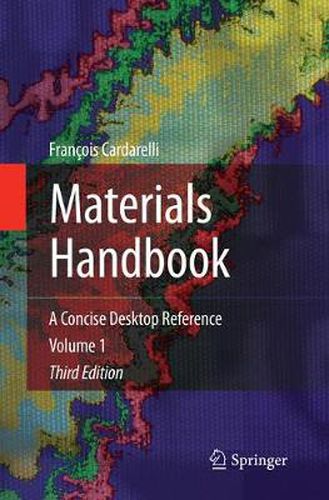Readings Newsletter
Become a Readings Member to make your shopping experience even easier.
Sign in or sign up for free!
You’re not far away from qualifying for FREE standard shipping within Australia
You’ve qualified for FREE standard shipping within Australia
The cart is loading…






The unique and practical Materials Handbook (third edition) provides quick and easy access to the physical and chemical properties of very many classes of materials. Its coverage has been expanded to include whole new families of materials such as minor metals, ferroalloys, nuclear materials, food, natural oils, fats, resins, and waxes. Many of the existing families-notably the metals, gases, liquids, minerals, rocks, soils, polymers, and fuels-are broadened and refined with new material and up-to-date information. Several of the larger tables of data are expanded and new ones added. Particular emphasis is placed on the properties of common industrial materials in each class. After a chapter introducing some general properties of materials, each of twenty-four classes of materials receives attention in its own chapter. The health and safety issues connected with the use and handling of industrial materials are included.
Detailed appendices provide additional information on subjects as diverse as crystallography, spectroscopy, thermochemical data, analytical chemistry, corrosion resistance, and economic data for industrial and hazardous materials. Specific further reading sections and a general bibliography round out this comprehensive guide. The index and tabular format of the book makes light work of extracting what the reader needs to know from the wealth of factual information within these covers.
Dr. Francois Cardarelli has spent many years compiling and editing materials data. His professional expertise and experience combine to make this handbook an indispensable reference tool for scientists and engineers working in numerous fields ranging from chemical to nuclear engineering. Particular emphasis is placed on the properties of common industrial materials in each class. After a chapter introducing some general properties of materials, materials are classified as follows.
ferrous metals and their
alloys; ferroalloys; common nonferrous
metals; less common metals; minor metals; semiconductors and
superconductors; magnetic materials; insulators and dielectrics; miscellaneous electrical
materials; ceramics, refractories and
glasses; polymers and elastomers; minerals, ores and
gemstones; rocks and meteorites;
soils and fertilizers;
construction materials; timbers and woods; fuels, propellants and
explosives; composite materials; gases; liquids; food, oils, resin and waxes; nuclear materials. food materials
$9.00 standard shipping within Australia
FREE standard shipping within Australia for orders over $100.00
Express & International shipping calculated at checkout
The unique and practical Materials Handbook (third edition) provides quick and easy access to the physical and chemical properties of very many classes of materials. Its coverage has been expanded to include whole new families of materials such as minor metals, ferroalloys, nuclear materials, food, natural oils, fats, resins, and waxes. Many of the existing families-notably the metals, gases, liquids, minerals, rocks, soils, polymers, and fuels-are broadened and refined with new material and up-to-date information. Several of the larger tables of data are expanded and new ones added. Particular emphasis is placed on the properties of common industrial materials in each class. After a chapter introducing some general properties of materials, each of twenty-four classes of materials receives attention in its own chapter. The health and safety issues connected with the use and handling of industrial materials are included.
Detailed appendices provide additional information on subjects as diverse as crystallography, spectroscopy, thermochemical data, analytical chemistry, corrosion resistance, and economic data for industrial and hazardous materials. Specific further reading sections and a general bibliography round out this comprehensive guide. The index and tabular format of the book makes light work of extracting what the reader needs to know from the wealth of factual information within these covers.
Dr. Francois Cardarelli has spent many years compiling and editing materials data. His professional expertise and experience combine to make this handbook an indispensable reference tool for scientists and engineers working in numerous fields ranging from chemical to nuclear engineering. Particular emphasis is placed on the properties of common industrial materials in each class. After a chapter introducing some general properties of materials, materials are classified as follows.
ferrous metals and their
alloys; ferroalloys; common nonferrous
metals; less common metals; minor metals; semiconductors and
superconductors; magnetic materials; insulators and dielectrics; miscellaneous electrical
materials; ceramics, refractories and
glasses; polymers and elastomers; minerals, ores and
gemstones; rocks and meteorites;
soils and fertilizers;
construction materials; timbers and woods; fuels, propellants and
explosives; composite materials; gases; liquids; food, oils, resin and waxes; nuclear materials. food materials